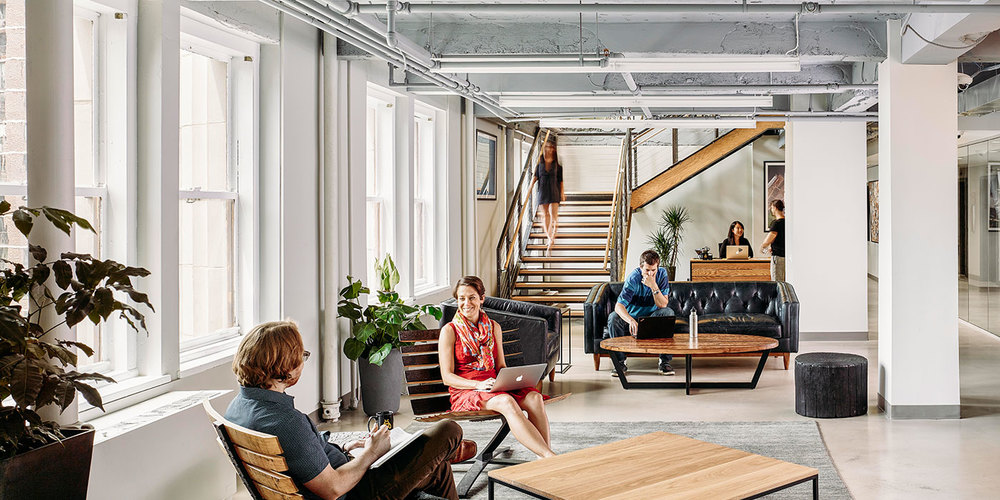Pictured Above: Eddie Bauer’s Redmond, WA office, designed by Callison Architecture using human centric design (Photo: Behance)
The workplace is changing as a result of pressure from both employers and employees. At one side is the pressure to cut cost and make spaces smaller. On the other side are the people who occupy these spaces.
The real estate aspect was easy to address, initially. Designing a space to minimize square footage per occupant requires some basic math. But creating a space that employees thrive in requires a new way of thinking. As organizations increasingly realize the value of attracting and retaining top talent, there’s been a movement to create a more human centric workplace.
Human Centric Design
Human centric design provides the basis for a human centric workplace.
The concept of human centric designs stems from “Design Thinking”, an idea popularized by design firm IDEO. They’ve used the concept on everything from hospital recovery room design to children’s toothbrushes. The idea is now making it’s way to the workplace.
At a panel discussion last year Metropolis Magazine’s editor,Susan Szenasy, started the conversation around human centric design with the acknowledgment that “We’re seeing a grassroots movement toward the inclusion of every human, talent, and skill.” Organizations have realized that a one-size-fits-all approach can’t be used. Fully open offices or private offices don’t work. There isn’t a magic ratio between open and private spaces either. To design better, the human aspect of each individual organization must be considered. It’s why a human centric approach is so important.
A starting point to create a human centric workplace is to utilize IDEO’s framework below. It allows designers to look at the end user of a design. In the workplace this means putting employees at the forefront of design.

IDEO’s Design Thinking Process (Image: Hyper Island )
While there are many different frameworks which can be applied for human centric design, the approach above has been highlighted because of it’s simplicity. The questions provided at each stage are guidelines for how designers can think when designing a human centric workplace.
Observing the workplace (Inspiration)
Inspiration for a human centric workplace comes from observing those who will be using it. This is an area where designers can draw on specifics of the organization. While the process is time consuming, it’s not new. Organizations like Callison Architecture used the approach in the 1990s when designing the corporate Headquarters for Eddie Bauer. In an IIDA feature, Andrea Vanecko, a Principle at the firm noted “Before we did anything, we told the client that we wanted to come work in their office for three weeks” They wanted to actually get in the head of the end users to create a product they would embrace.
Physically observing how work is completed in person can capture aspects of work and culture that employee surveys simply cannot.
What designs enable employee productivity and happiness? (Ideation)
In the ideation phase it’s important to keep an open mind and generate as many ideas as possible. Next look at how these ideas would improve the workplace for employees. Keeping occupants at the forefront of the process will allow you to rule out idea that don’t make sense. What you are left with are viable options for the implementation phase. It allows you to test your solution and incorporate the most feedback possible.
Examples of ideas that may arise through the ideation process include the use of biophillia in office design. Diane Rogers of IA notes that “Biophilia talks about our connection to the world of living things..It’s a good framework for the design process because it gets you contemplating about what users of the space need.” The positive effects that biophillic design can have in the workplace may have not been realized without looking at what users need.
Bringing your idea to life and prototyping (Implementation)
Feedback does not stop at the implementation phase in human centric design. Applying the prototyping model in an office environment is a bit different that product design. However it is still possible. Modular furniture systems that provide more flexibility allow for organization to shift and adapt designs on the go. This iterative process provides benefits for employees in the long run.
Testing layouts on a smaller scale is also possible. Corgan utilized this approach when designing the new Southwest Airlines office, for example. This was particularly important when dealing with an organization so centered on their employees. As a result the space was able to embody Southwest’s brand as well.
By the time your design reaches the full implementation phase you’ll have a better idea of what the employees want and how it also meets the client’s needs and expectations. It’s also important to create measures for success based around the key metrics you and your client have decided upon.
The best part about the implementation phase is that once you have taken the time to observe and continually get feedback from employees, they tend to embrace the outcome a lot more.



